Craft Beer Export Strategies: Brazil & India
VerifiedAdded on 2020/02/24
|15
|3930
|99
AI Summary
This assignment delves into the complexities of exporting craft beers from Brazil to India. It requires an analysis of both markets, considering factors like consumer preferences, economic conditions (inflation rates, GDP), and political landscapes (corruption levels, government policies). Students need to evaluate potential risks and opportunities, propose suitable export strategies, and discuss the impact of cultural differences on market success. The analysis should draw upon academic sources, economic data, and real-world examples within the craft beer industry.
Contribute Materials
Your contribution can guide someone’s learning journey. Share your
documents today.
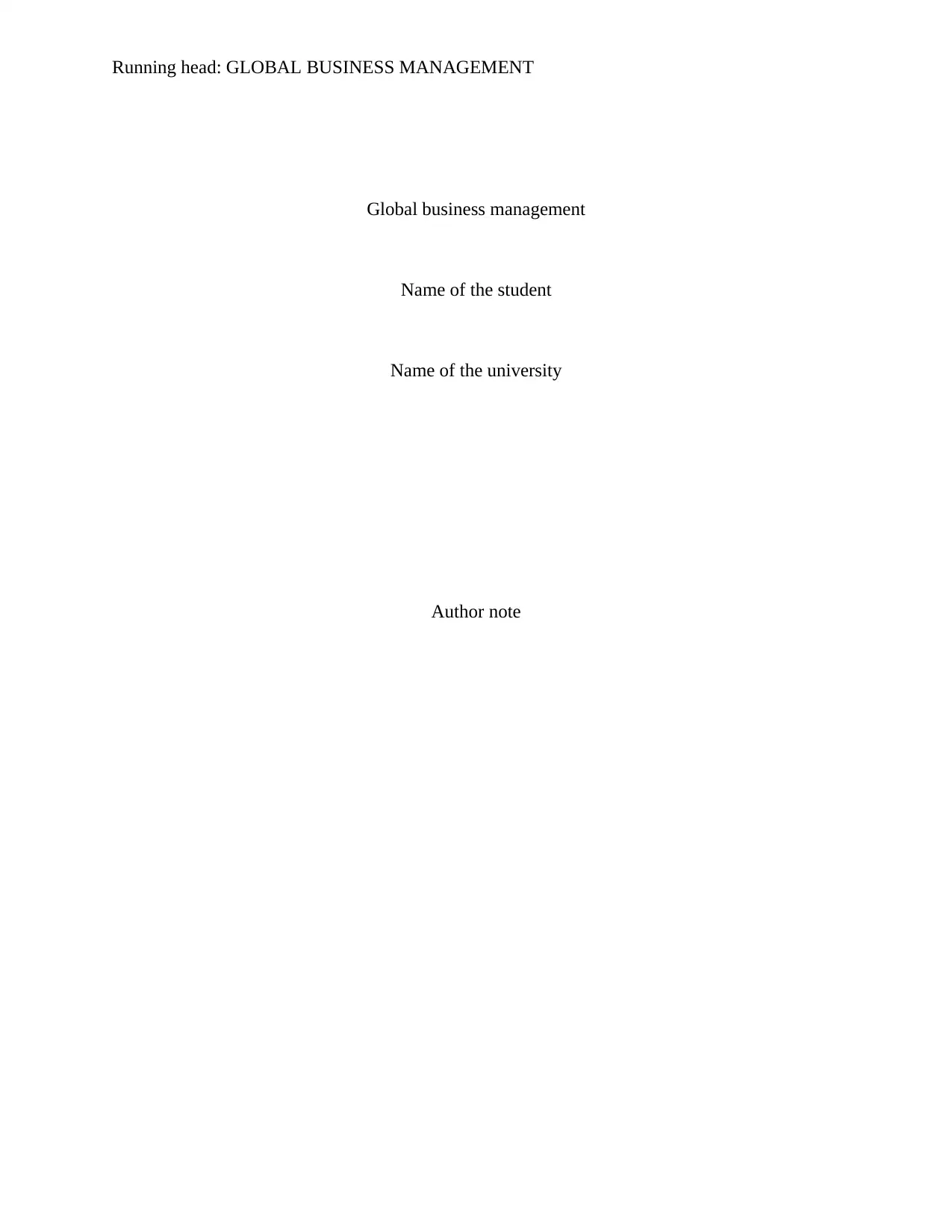
Running head: GLOBAL BUSINESS MANAGEMENT
Global business management
Name of the student
Name of the university
Author note
Global business management
Name of the student
Name of the university
Author note
Secure Best Marks with AI Grader
Need help grading? Try our AI Grader for instant feedback on your assignments.
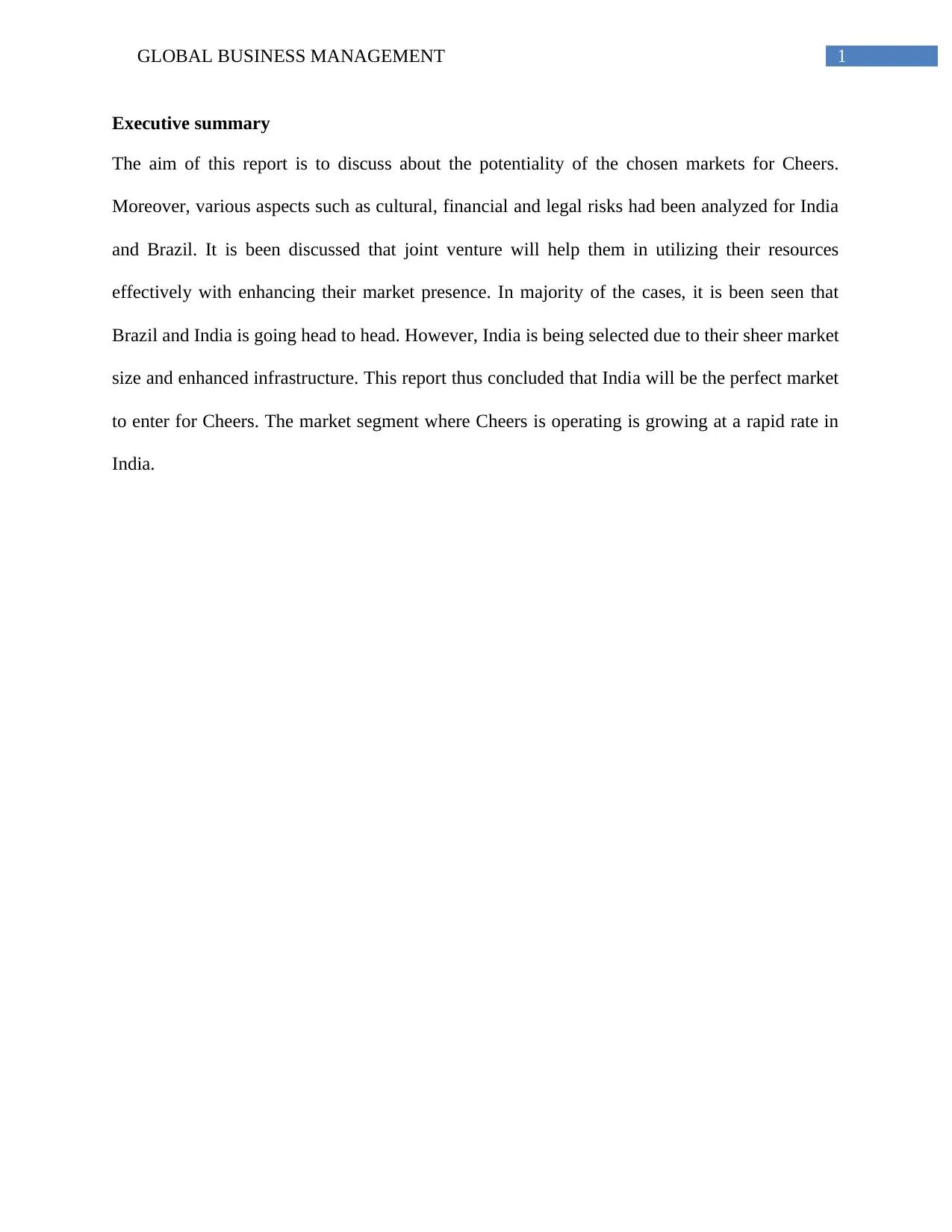
1GLOBAL BUSINESS MANAGEMENT
Executive summary
The aim of this report is to discuss about the potentiality of the chosen markets for Cheers.
Moreover, various aspects such as cultural, financial and legal risks had been analyzed for India
and Brazil. It is been discussed that joint venture will help them in utilizing their resources
effectively with enhancing their market presence. In majority of the cases, it is been seen that
Brazil and India is going head to head. However, India is being selected due to their sheer market
size and enhanced infrastructure. This report thus concluded that India will be the perfect market
to enter for Cheers. The market segment where Cheers is operating is growing at a rapid rate in
India.
Executive summary
The aim of this report is to discuss about the potentiality of the chosen markets for Cheers.
Moreover, various aspects such as cultural, financial and legal risks had been analyzed for India
and Brazil. It is been discussed that joint venture will help them in utilizing their resources
effectively with enhancing their market presence. In majority of the cases, it is been seen that
Brazil and India is going head to head. However, India is being selected due to their sheer market
size and enhanced infrastructure. This report thus concluded that India will be the perfect market
to enter for Cheers. The market segment where Cheers is operating is growing at a rapid rate in
India.
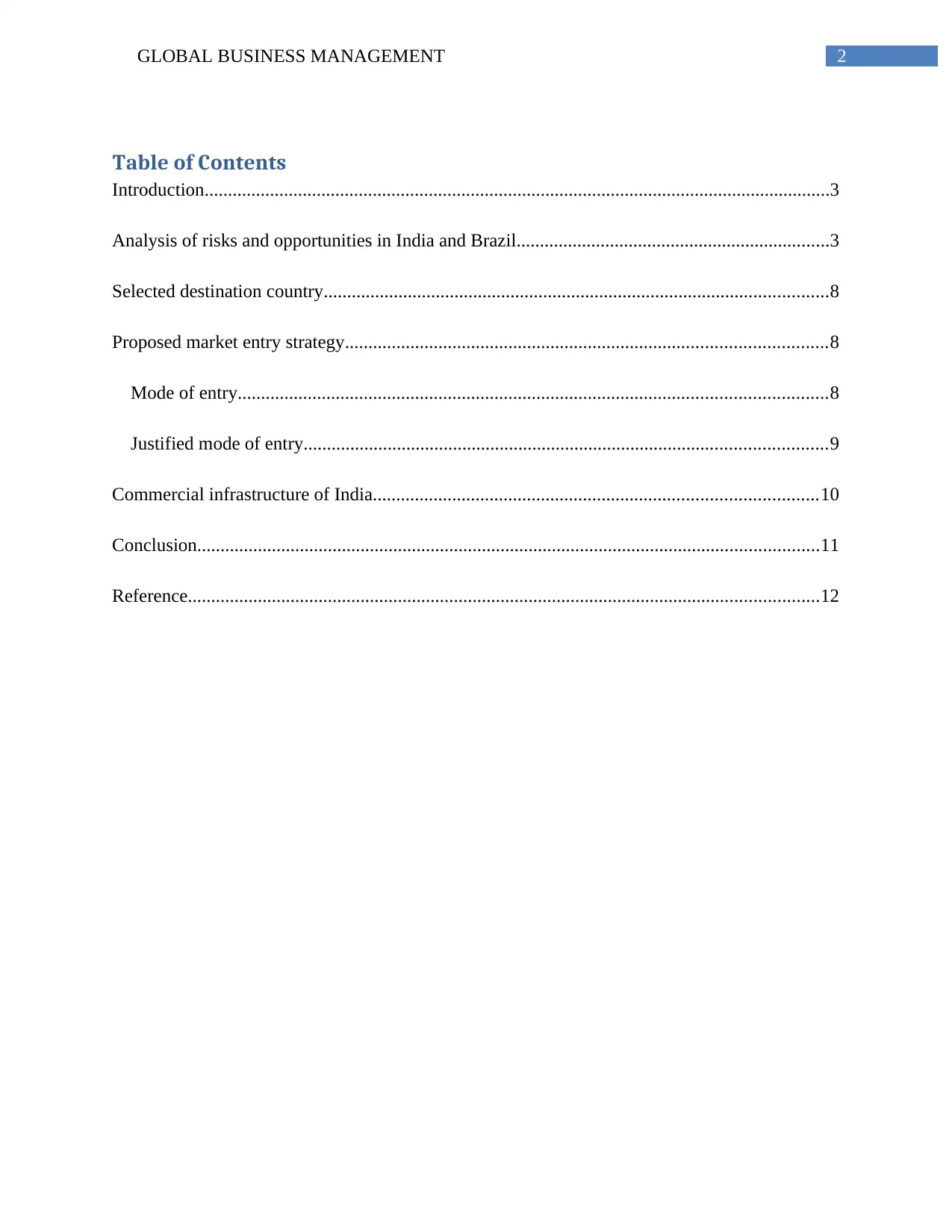
2GLOBAL BUSINESS MANAGEMENT
Table of Contents
Introduction......................................................................................................................................3
Analysis of risks and opportunities in India and Brazil...................................................................3
Selected destination country............................................................................................................8
Proposed market entry strategy.......................................................................................................8
Mode of entry..............................................................................................................................8
Justified mode of entry................................................................................................................9
Commercial infrastructure of India...............................................................................................10
Conclusion.....................................................................................................................................11
Reference.......................................................................................................................................12
Table of Contents
Introduction......................................................................................................................................3
Analysis of risks and opportunities in India and Brazil...................................................................3
Selected destination country............................................................................................................8
Proposed market entry strategy.......................................................................................................8
Mode of entry..............................................................................................................................8
Justified mode of entry................................................................................................................9
Commercial infrastructure of India...............................................................................................10
Conclusion.....................................................................................................................................11
Reference.......................................................................................................................................12
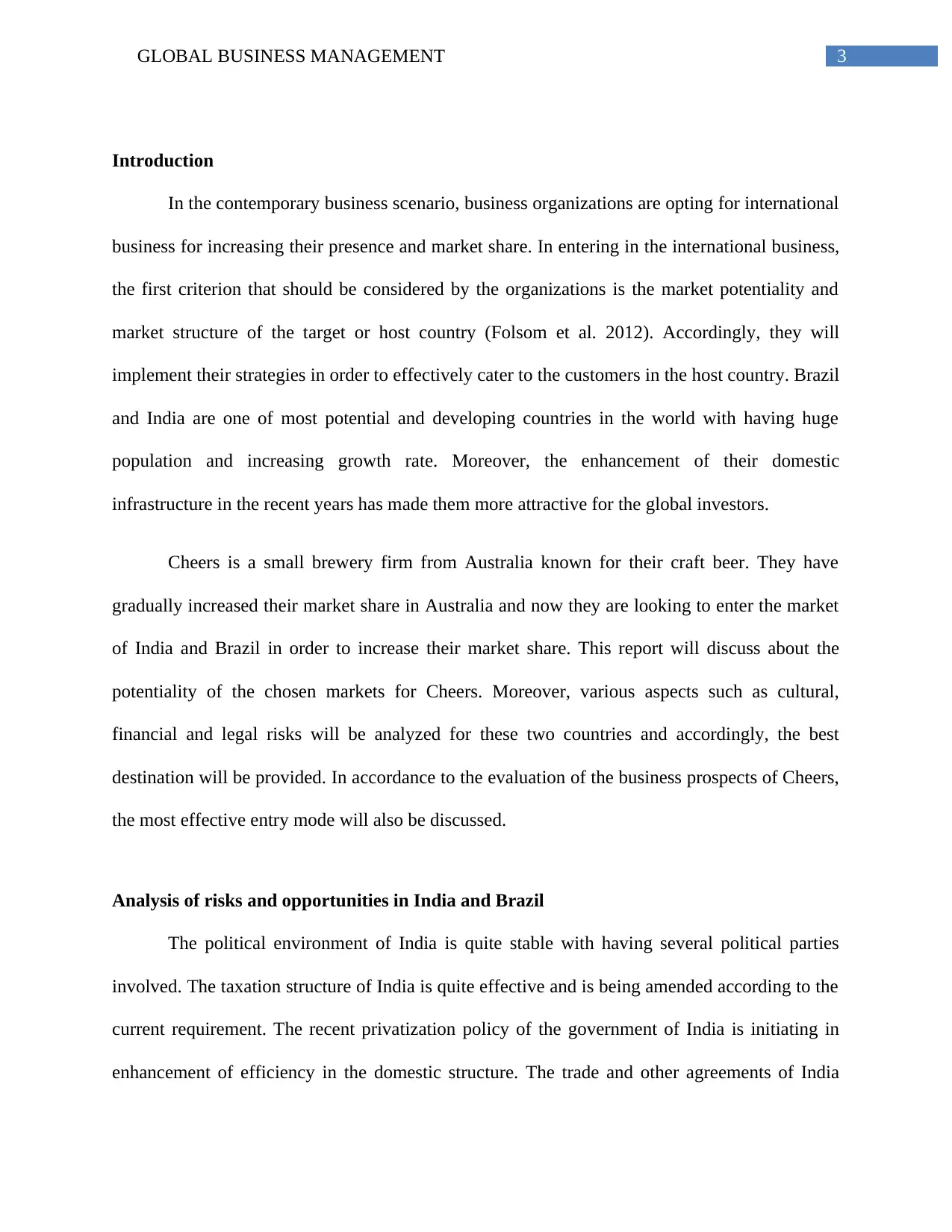
3GLOBAL BUSINESS MANAGEMENT
Introduction
In the contemporary business scenario, business organizations are opting for international
business for increasing their presence and market share. In entering in the international business,
the first criterion that should be considered by the organizations is the market potentiality and
market structure of the target or host country (Folsom et al. 2012). Accordingly, they will
implement their strategies in order to effectively cater to the customers in the host country. Brazil
and India are one of most potential and developing countries in the world with having huge
population and increasing growth rate. Moreover, the enhancement of their domestic
infrastructure in the recent years has made them more attractive for the global investors.
Cheers is a small brewery firm from Australia known for their craft beer. They have
gradually increased their market share in Australia and now they are looking to enter the market
of India and Brazil in order to increase their market share. This report will discuss about the
potentiality of the chosen markets for Cheers. Moreover, various aspects such as cultural,
financial and legal risks will be analyzed for these two countries and accordingly, the best
destination will be provided. In accordance to the evaluation of the business prospects of Cheers,
the most effective entry mode will also be discussed.
Analysis of risks and opportunities in India and Brazil
The political environment of India is quite stable with having several political parties
involved. The taxation structure of India is quite effective and is being amended according to the
current requirement. The recent privatization policy of the government of India is initiating in
enhancement of efficiency in the domestic structure. The trade and other agreements of India
Introduction
In the contemporary business scenario, business organizations are opting for international
business for increasing their presence and market share. In entering in the international business,
the first criterion that should be considered by the organizations is the market potentiality and
market structure of the target or host country (Folsom et al. 2012). Accordingly, they will
implement their strategies in order to effectively cater to the customers in the host country. Brazil
and India are one of most potential and developing countries in the world with having huge
population and increasing growth rate. Moreover, the enhancement of their domestic
infrastructure in the recent years has made them more attractive for the global investors.
Cheers is a small brewery firm from Australia known for their craft beer. They have
gradually increased their market share in Australia and now they are looking to enter the market
of India and Brazil in order to increase their market share. This report will discuss about the
potentiality of the chosen markets for Cheers. Moreover, various aspects such as cultural,
financial and legal risks will be analyzed for these two countries and accordingly, the best
destination will be provided. In accordance to the evaluation of the business prospects of Cheers,
the most effective entry mode will also be discussed.
Analysis of risks and opportunities in India and Brazil
The political environment of India is quite stable with having several political parties
involved. The taxation structure of India is quite effective and is being amended according to the
current requirement. The recent privatization policy of the government of India is initiating in
enhancement of efficiency in the domestic structure. The trade and other agreements of India
Secure Best Marks with AI Grader
Need help grading? Try our AI Grader for instant feedback on your assignments.
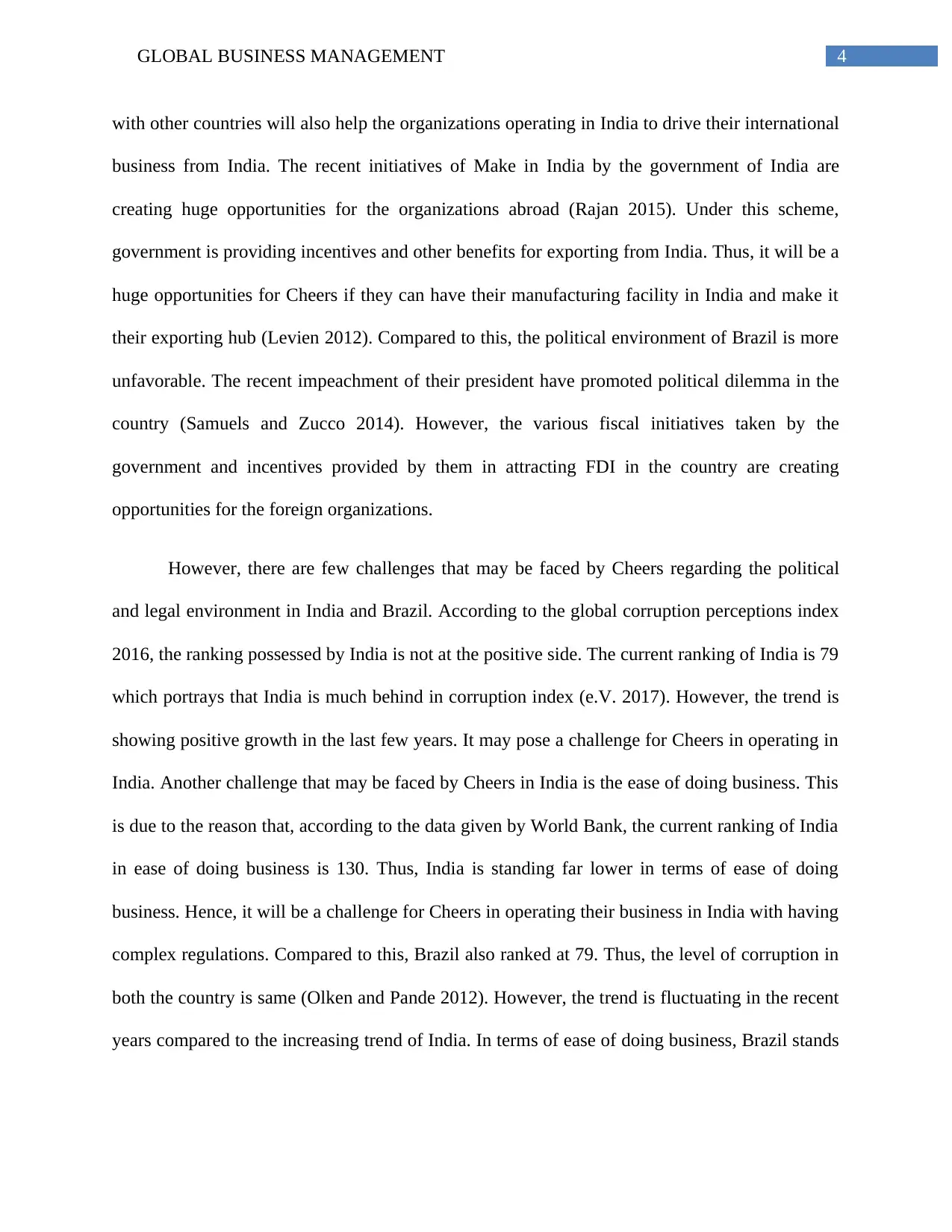
4GLOBAL BUSINESS MANAGEMENT
with other countries will also help the organizations operating in India to drive their international
business from India. The recent initiatives of Make in India by the government of India are
creating huge opportunities for the organizations abroad (Rajan 2015). Under this scheme,
government is providing incentives and other benefits for exporting from India. Thus, it will be a
huge opportunities for Cheers if they can have their manufacturing facility in India and make it
their exporting hub (Levien 2012). Compared to this, the political environment of Brazil is more
unfavorable. The recent impeachment of their president have promoted political dilemma in the
country (Samuels and Zucco 2014). However, the various fiscal initiatives taken by the
government and incentives provided by them in attracting FDI in the country are creating
opportunities for the foreign organizations.
However, there are few challenges that may be faced by Cheers regarding the political
and legal environment in India and Brazil. According to the global corruption perceptions index
2016, the ranking possessed by India is not at the positive side. The current ranking of India is 79
which portrays that India is much behind in corruption index (e.V. 2017). However, the trend is
showing positive growth in the last few years. It may pose a challenge for Cheers in operating in
India. Another challenge that may be faced by Cheers in India is the ease of doing business. This
is due to the reason that, according to the data given by World Bank, the current ranking of India
in ease of doing business is 130. Thus, India is standing far lower in terms of ease of doing
business. Hence, it will be a challenge for Cheers in operating their business in India with having
complex regulations. Compared to this, Brazil also ranked at 79. Thus, the level of corruption in
both the country is same (Olken and Pande 2012). However, the trend is fluctuating in the recent
years compared to the increasing trend of India. In terms of ease of doing business, Brazil stands
with other countries will also help the organizations operating in India to drive their international
business from India. The recent initiatives of Make in India by the government of India are
creating huge opportunities for the organizations abroad (Rajan 2015). Under this scheme,
government is providing incentives and other benefits for exporting from India. Thus, it will be a
huge opportunities for Cheers if they can have their manufacturing facility in India and make it
their exporting hub (Levien 2012). Compared to this, the political environment of Brazil is more
unfavorable. The recent impeachment of their president have promoted political dilemma in the
country (Samuels and Zucco 2014). However, the various fiscal initiatives taken by the
government and incentives provided by them in attracting FDI in the country are creating
opportunities for the foreign organizations.
However, there are few challenges that may be faced by Cheers regarding the political
and legal environment in India and Brazil. According to the global corruption perceptions index
2016, the ranking possessed by India is not at the positive side. The current ranking of India is 79
which portrays that India is much behind in corruption index (e.V. 2017). However, the trend is
showing positive growth in the last few years. It may pose a challenge for Cheers in operating in
India. Another challenge that may be faced by Cheers in India is the ease of doing business. This
is due to the reason that, according to the data given by World Bank, the current ranking of India
in ease of doing business is 130. Thus, India is standing far lower in terms of ease of doing
business. Hence, it will be a challenge for Cheers in operating their business in India with having
complex regulations. Compared to this, Brazil also ranked at 79. Thus, the level of corruption in
both the country is same (Olken and Pande 2012). However, the trend is fluctuating in the recent
years compared to the increasing trend of India. In terms of ease of doing business, Brazil stands
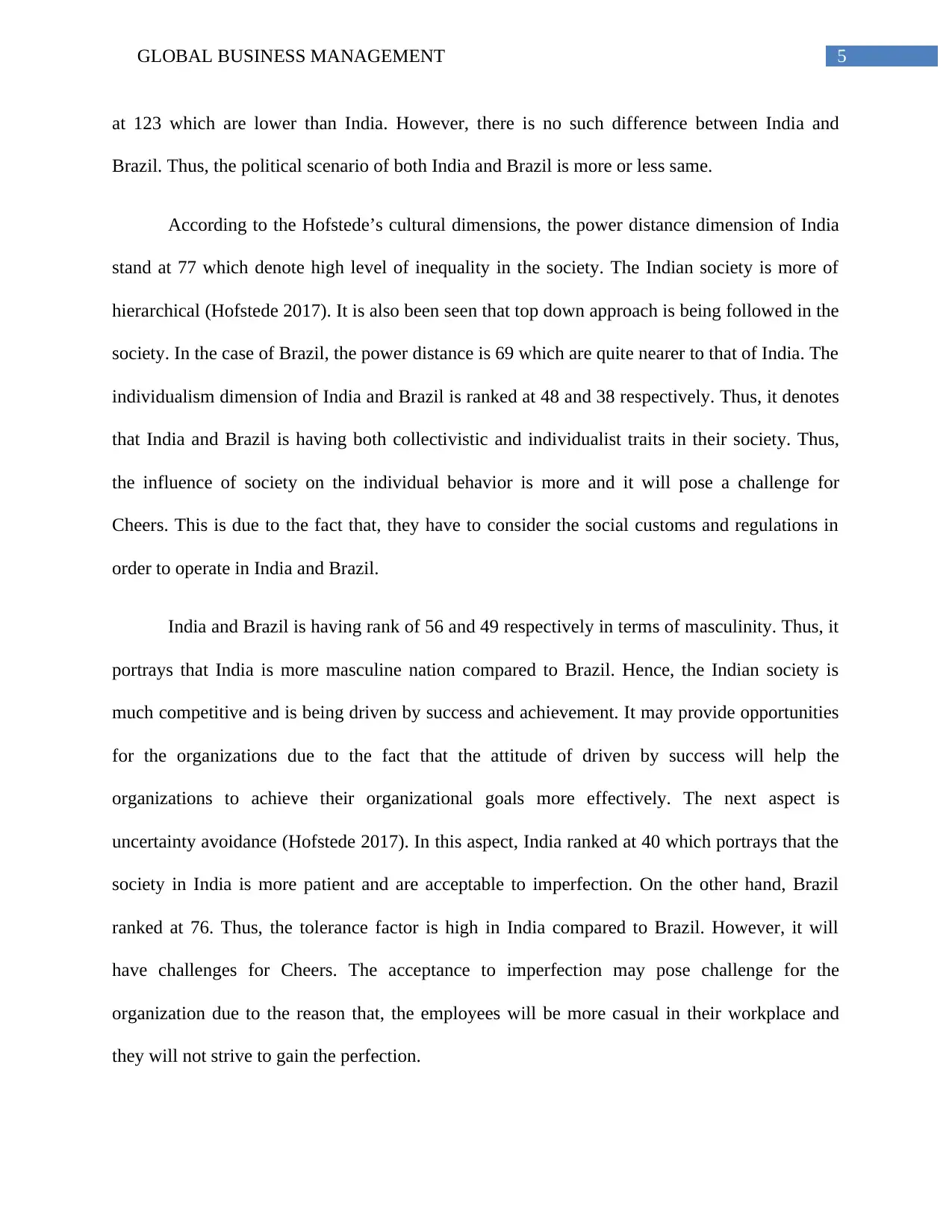
5GLOBAL BUSINESS MANAGEMENT
at 123 which are lower than India. However, there is no such difference between India and
Brazil. Thus, the political scenario of both India and Brazil is more or less same.
According to the Hofstede’s cultural dimensions, the power distance dimension of India
stand at 77 which denote high level of inequality in the society. The Indian society is more of
hierarchical (Hofstede 2017). It is also been seen that top down approach is being followed in the
society. In the case of Brazil, the power distance is 69 which are quite nearer to that of India. The
individualism dimension of India and Brazil is ranked at 48 and 38 respectively. Thus, it denotes
that India and Brazil is having both collectivistic and individualist traits in their society. Thus,
the influence of society on the individual behavior is more and it will pose a challenge for
Cheers. This is due to the fact that, they have to consider the social customs and regulations in
order to operate in India and Brazil.
India and Brazil is having rank of 56 and 49 respectively in terms of masculinity. Thus, it
portrays that India is more masculine nation compared to Brazil. Hence, the Indian society is
much competitive and is being driven by success and achievement. It may provide opportunities
for the organizations due to the fact that the attitude of driven by success will help the
organizations to achieve their organizational goals more effectively. The next aspect is
uncertainty avoidance (Hofstede 2017). In this aspect, India ranked at 40 which portrays that the
society in India is more patient and are acceptable to imperfection. On the other hand, Brazil
ranked at 76. Thus, the tolerance factor is high in India compared to Brazil. However, it will
have challenges for Cheers. The acceptance to imperfection may pose challenge for the
organization due to the reason that, the employees will be more casual in their workplace and
they will not strive to gain the perfection.
at 123 which are lower than India. However, there is no such difference between India and
Brazil. Thus, the political scenario of both India and Brazil is more or less same.
According to the Hofstede’s cultural dimensions, the power distance dimension of India
stand at 77 which denote high level of inequality in the society. The Indian society is more of
hierarchical (Hofstede 2017). It is also been seen that top down approach is being followed in the
society. In the case of Brazil, the power distance is 69 which are quite nearer to that of India. The
individualism dimension of India and Brazil is ranked at 48 and 38 respectively. Thus, it denotes
that India and Brazil is having both collectivistic and individualist traits in their society. Thus,
the influence of society on the individual behavior is more and it will pose a challenge for
Cheers. This is due to the fact that, they have to consider the social customs and regulations in
order to operate in India and Brazil.
India and Brazil is having rank of 56 and 49 respectively in terms of masculinity. Thus, it
portrays that India is more masculine nation compared to Brazil. Hence, the Indian society is
much competitive and is being driven by success and achievement. It may provide opportunities
for the organizations due to the fact that the attitude of driven by success will help the
organizations to achieve their organizational goals more effectively. The next aspect is
uncertainty avoidance (Hofstede 2017). In this aspect, India ranked at 40 which portrays that the
society in India is more patient and are acceptable to imperfection. On the other hand, Brazil
ranked at 76. Thus, the tolerance factor is high in India compared to Brazil. However, it will
have challenges for Cheers. The acceptance to imperfection may pose challenge for the
organization due to the reason that, the employees will be more casual in their workplace and
they will not strive to gain the perfection.
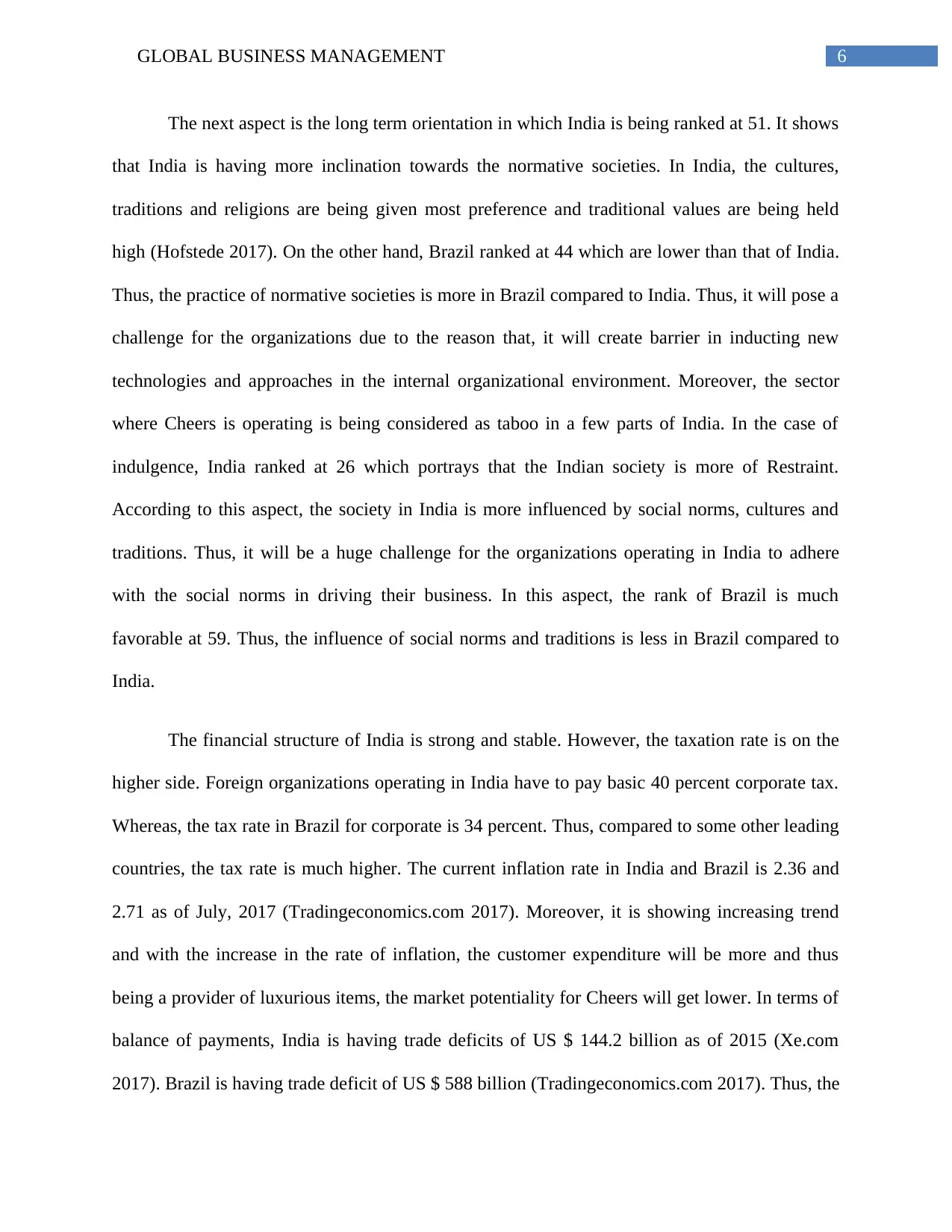
6GLOBAL BUSINESS MANAGEMENT
The next aspect is the long term orientation in which India is being ranked at 51. It shows
that India is having more inclination towards the normative societies. In India, the cultures,
traditions and religions are being given most preference and traditional values are being held
high (Hofstede 2017). On the other hand, Brazil ranked at 44 which are lower than that of India.
Thus, the practice of normative societies is more in Brazil compared to India. Thus, it will pose a
challenge for the organizations due to the reason that, it will create barrier in inducting new
technologies and approaches in the internal organizational environment. Moreover, the sector
where Cheers is operating is being considered as taboo in a few parts of India. In the case of
indulgence, India ranked at 26 which portrays that the Indian society is more of Restraint.
According to this aspect, the society in India is more influenced by social norms, cultures and
traditions. Thus, it will be a huge challenge for the organizations operating in India to adhere
with the social norms in driving their business. In this aspect, the rank of Brazil is much
favorable at 59. Thus, the influence of social norms and traditions is less in Brazil compared to
India.
The financial structure of India is strong and stable. However, the taxation rate is on the
higher side. Foreign organizations operating in India have to pay basic 40 percent corporate tax.
Whereas, the tax rate in Brazil for corporate is 34 percent. Thus, compared to some other leading
countries, the tax rate is much higher. The current inflation rate in India and Brazil is 2.36 and
2.71 as of July, 2017 (Tradingeconomics.com 2017). Moreover, it is showing increasing trend
and with the increase in the rate of inflation, the customer expenditure will be more and thus
being a provider of luxurious items, the market potentiality for Cheers will get lower. In terms of
balance of payments, India is having trade deficits of US $ 144.2 billion as of 2015 (Xe.com
2017). Brazil is having trade deficit of US $ 588 billion (Tradingeconomics.com 2017). Thus, the
The next aspect is the long term orientation in which India is being ranked at 51. It shows
that India is having more inclination towards the normative societies. In India, the cultures,
traditions and religions are being given most preference and traditional values are being held
high (Hofstede 2017). On the other hand, Brazil ranked at 44 which are lower than that of India.
Thus, the practice of normative societies is more in Brazil compared to India. Thus, it will pose a
challenge for the organizations due to the reason that, it will create barrier in inducting new
technologies and approaches in the internal organizational environment. Moreover, the sector
where Cheers is operating is being considered as taboo in a few parts of India. In the case of
indulgence, India ranked at 26 which portrays that the Indian society is more of Restraint.
According to this aspect, the society in India is more influenced by social norms, cultures and
traditions. Thus, it will be a huge challenge for the organizations operating in India to adhere
with the social norms in driving their business. In this aspect, the rank of Brazil is much
favorable at 59. Thus, the influence of social norms and traditions is less in Brazil compared to
India.
The financial structure of India is strong and stable. However, the taxation rate is on the
higher side. Foreign organizations operating in India have to pay basic 40 percent corporate tax.
Whereas, the tax rate in Brazil for corporate is 34 percent. Thus, compared to some other leading
countries, the tax rate is much higher. The current inflation rate in India and Brazil is 2.36 and
2.71 as of July, 2017 (Tradingeconomics.com 2017). Moreover, it is showing increasing trend
and with the increase in the rate of inflation, the customer expenditure will be more and thus
being a provider of luxurious items, the market potentiality for Cheers will get lower. In terms of
balance of payments, India is having trade deficits of US $ 144.2 billion as of 2015 (Xe.com
2017). Brazil is having trade deficit of US $ 588 billion (Tradingeconomics.com 2017). Thus, the
Paraphrase This Document
Need a fresh take? Get an instant paraphrase of this document with our AI Paraphraser
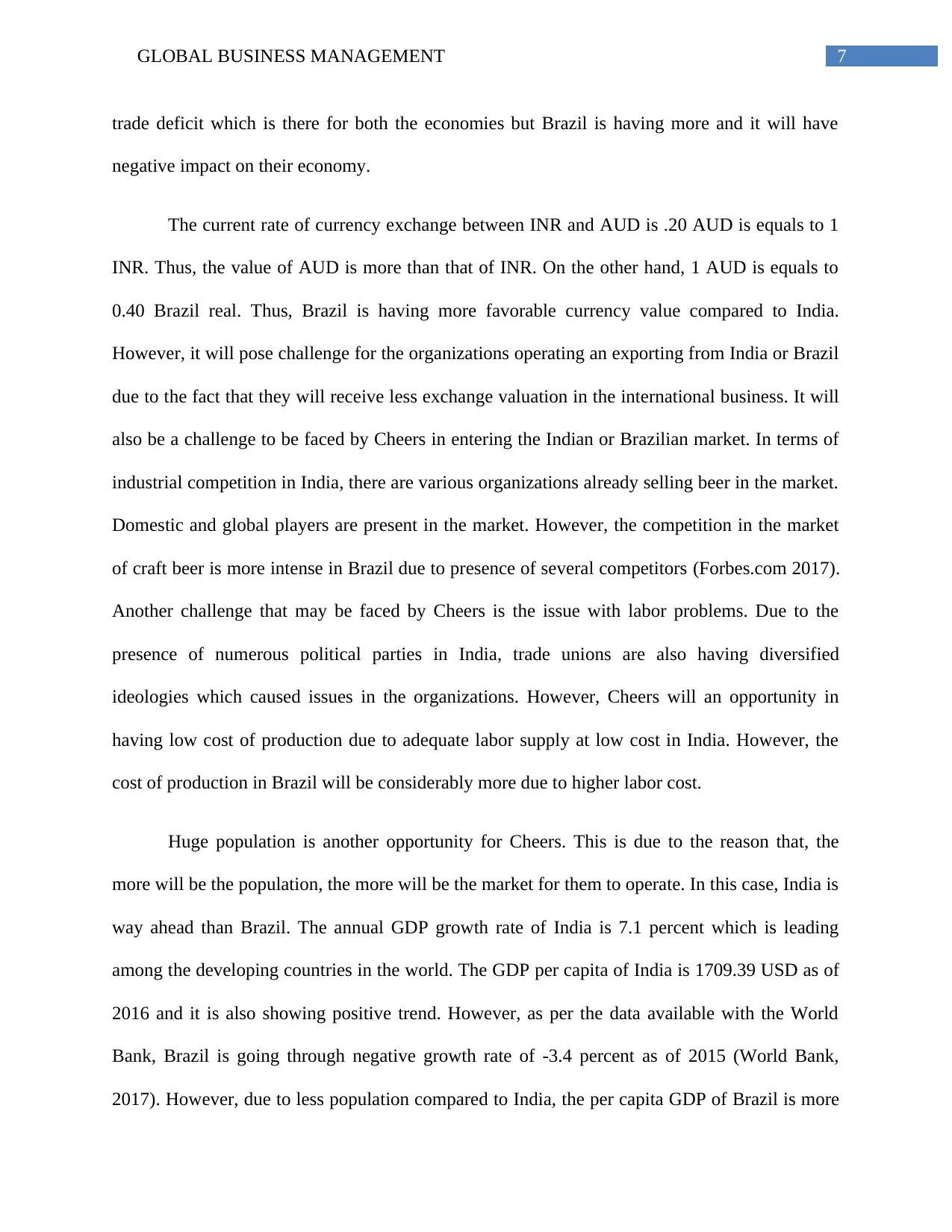
7GLOBAL BUSINESS MANAGEMENT
trade deficit which is there for both the economies but Brazil is having more and it will have
negative impact on their economy.
The current rate of currency exchange between INR and AUD is .20 AUD is equals to 1
INR. Thus, the value of AUD is more than that of INR. On the other hand, 1 AUD is equals to
0.40 Brazil real. Thus, Brazil is having more favorable currency value compared to India.
However, it will pose challenge for the organizations operating an exporting from India or Brazil
due to the fact that they will receive less exchange valuation in the international business. It will
also be a challenge to be faced by Cheers in entering the Indian or Brazilian market. In terms of
industrial competition in India, there are various organizations already selling beer in the market.
Domestic and global players are present in the market. However, the competition in the market
of craft beer is more intense in Brazil due to presence of several competitors (Forbes.com 2017).
Another challenge that may be faced by Cheers is the issue with labor problems. Due to the
presence of numerous political parties in India, trade unions are also having diversified
ideologies which caused issues in the organizations. However, Cheers will an opportunity in
having low cost of production due to adequate labor supply at low cost in India. However, the
cost of production in Brazil will be considerably more due to higher labor cost.
Huge population is another opportunity for Cheers. This is due to the reason that, the
more will be the population, the more will be the market for them to operate. In this case, India is
way ahead than Brazil. The annual GDP growth rate of India is 7.1 percent which is leading
among the developing countries in the world. The GDP per capita of India is 1709.39 USD as of
2016 and it is also showing positive trend. However, as per the data available with the World
Bank, Brazil is going through negative growth rate of -3.4 percent as of 2015 (World Bank,
2017). However, due to less population compared to India, the per capita GDP of Brazil is more
trade deficit which is there for both the economies but Brazil is having more and it will have
negative impact on their economy.
The current rate of currency exchange between INR and AUD is .20 AUD is equals to 1
INR. Thus, the value of AUD is more than that of INR. On the other hand, 1 AUD is equals to
0.40 Brazil real. Thus, Brazil is having more favorable currency value compared to India.
However, it will pose challenge for the organizations operating an exporting from India or Brazil
due to the fact that they will receive less exchange valuation in the international business. It will
also be a challenge to be faced by Cheers in entering the Indian or Brazilian market. In terms of
industrial competition in India, there are various organizations already selling beer in the market.
Domestic and global players are present in the market. However, the competition in the market
of craft beer is more intense in Brazil due to presence of several competitors (Forbes.com 2017).
Another challenge that may be faced by Cheers is the issue with labor problems. Due to the
presence of numerous political parties in India, trade unions are also having diversified
ideologies which caused issues in the organizations. However, Cheers will an opportunity in
having low cost of production due to adequate labor supply at low cost in India. However, the
cost of production in Brazil will be considerably more due to higher labor cost.
Huge population is another opportunity for Cheers. This is due to the reason that, the
more will be the population, the more will be the market for them to operate. In this case, India is
way ahead than Brazil. The annual GDP growth rate of India is 7.1 percent which is leading
among the developing countries in the world. The GDP per capita of India is 1709.39 USD as of
2016 and it is also showing positive trend. However, as per the data available with the World
Bank, Brazil is going through negative growth rate of -3.4 percent as of 2015 (World Bank,
2017). However, due to less population compared to India, the per capita GDP of Brazil is more
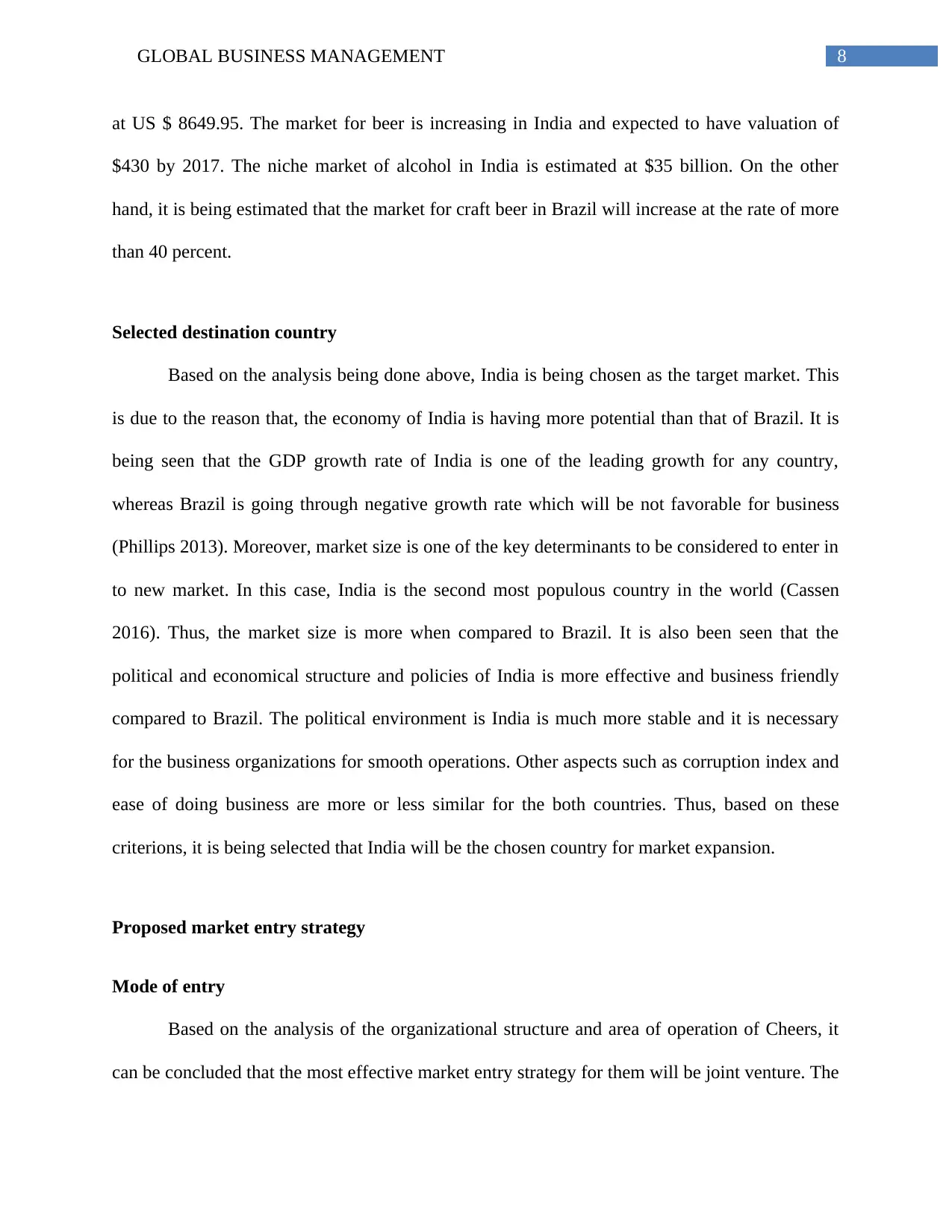
8GLOBAL BUSINESS MANAGEMENT
at US $ 8649.95. The market for beer is increasing in India and expected to have valuation of
$430 by 2017. The niche market of alcohol in India is estimated at $35 billion. On the other
hand, it is being estimated that the market for craft beer in Brazil will increase at the rate of more
than 40 percent.
Selected destination country
Based on the analysis being done above, India is being chosen as the target market. This
is due to the reason that, the economy of India is having more potential than that of Brazil. It is
being seen that the GDP growth rate of India is one of the leading growth for any country,
whereas Brazil is going through negative growth rate which will be not favorable for business
(Phillips 2013). Moreover, market size is one of the key determinants to be considered to enter in
to new market. In this case, India is the second most populous country in the world (Cassen
2016). Thus, the market size is more when compared to Brazil. It is also been seen that the
political and economical structure and policies of India is more effective and business friendly
compared to Brazil. The political environment is India is much more stable and it is necessary
for the business organizations for smooth operations. Other aspects such as corruption index and
ease of doing business are more or less similar for the both countries. Thus, based on these
criterions, it is being selected that India will be the chosen country for market expansion.
Proposed market entry strategy
Mode of entry
Based on the analysis of the organizational structure and area of operation of Cheers, it
can be concluded that the most effective market entry strategy for them will be joint venture. The
at US $ 8649.95. The market for beer is increasing in India and expected to have valuation of
$430 by 2017. The niche market of alcohol in India is estimated at $35 billion. On the other
hand, it is being estimated that the market for craft beer in Brazil will increase at the rate of more
than 40 percent.
Selected destination country
Based on the analysis being done above, India is being chosen as the target market. This
is due to the reason that, the economy of India is having more potential than that of Brazil. It is
being seen that the GDP growth rate of India is one of the leading growth for any country,
whereas Brazil is going through negative growth rate which will be not favorable for business
(Phillips 2013). Moreover, market size is one of the key determinants to be considered to enter in
to new market. In this case, India is the second most populous country in the world (Cassen
2016). Thus, the market size is more when compared to Brazil. It is also been seen that the
political and economical structure and policies of India is more effective and business friendly
compared to Brazil. The political environment is India is much more stable and it is necessary
for the business organizations for smooth operations. Other aspects such as corruption index and
ease of doing business are more or less similar for the both countries. Thus, based on these
criterions, it is being selected that India will be the chosen country for market expansion.
Proposed market entry strategy
Mode of entry
Based on the analysis of the organizational structure and area of operation of Cheers, it
can be concluded that the most effective market entry strategy for them will be joint venture. The
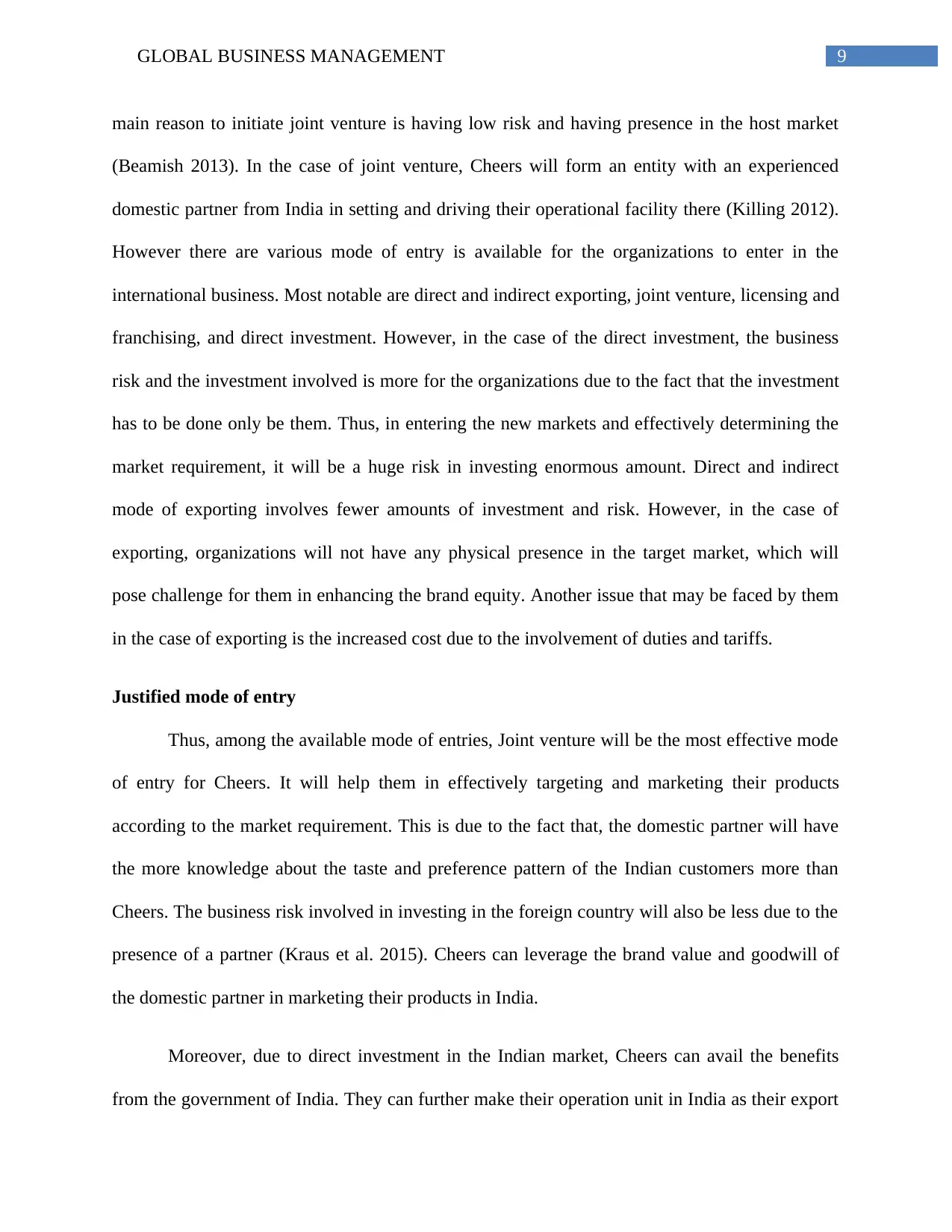
9GLOBAL BUSINESS MANAGEMENT
main reason to initiate joint venture is having low risk and having presence in the host market
(Beamish 2013). In the case of joint venture, Cheers will form an entity with an experienced
domestic partner from India in setting and driving their operational facility there (Killing 2012).
However there are various mode of entry is available for the organizations to enter in the
international business. Most notable are direct and indirect exporting, joint venture, licensing and
franchising, and direct investment. However, in the case of the direct investment, the business
risk and the investment involved is more for the organizations due to the fact that the investment
has to be done only be them. Thus, in entering the new markets and effectively determining the
market requirement, it will be a huge risk in investing enormous amount. Direct and indirect
mode of exporting involves fewer amounts of investment and risk. However, in the case of
exporting, organizations will not have any physical presence in the target market, which will
pose challenge for them in enhancing the brand equity. Another issue that may be faced by them
in the case of exporting is the increased cost due to the involvement of duties and tariffs.
Justified mode of entry
Thus, among the available mode of entries, Joint venture will be the most effective mode
of entry for Cheers. It will help them in effectively targeting and marketing their products
according to the market requirement. This is due to the fact that, the domestic partner will have
the more knowledge about the taste and preference pattern of the Indian customers more than
Cheers. The business risk involved in investing in the foreign country will also be less due to the
presence of a partner (Kraus et al. 2015). Cheers can leverage the brand value and goodwill of
the domestic partner in marketing their products in India.
Moreover, due to direct investment in the Indian market, Cheers can avail the benefits
from the government of India. They can further make their operation unit in India as their export
main reason to initiate joint venture is having low risk and having presence in the host market
(Beamish 2013). In the case of joint venture, Cheers will form an entity with an experienced
domestic partner from India in setting and driving their operational facility there (Killing 2012).
However there are various mode of entry is available for the organizations to enter in the
international business. Most notable are direct and indirect exporting, joint venture, licensing and
franchising, and direct investment. However, in the case of the direct investment, the business
risk and the investment involved is more for the organizations due to the fact that the investment
has to be done only be them. Thus, in entering the new markets and effectively determining the
market requirement, it will be a huge risk in investing enormous amount. Direct and indirect
mode of exporting involves fewer amounts of investment and risk. However, in the case of
exporting, organizations will not have any physical presence in the target market, which will
pose challenge for them in enhancing the brand equity. Another issue that may be faced by them
in the case of exporting is the increased cost due to the involvement of duties and tariffs.
Justified mode of entry
Thus, among the available mode of entries, Joint venture will be the most effective mode
of entry for Cheers. It will help them in effectively targeting and marketing their products
according to the market requirement. This is due to the fact that, the domestic partner will have
the more knowledge about the taste and preference pattern of the Indian customers more than
Cheers. The business risk involved in investing in the foreign country will also be less due to the
presence of a partner (Kraus et al. 2015). Cheers can leverage the brand value and goodwill of
the domestic partner in marketing their products in India.
Moreover, due to direct investment in the Indian market, Cheers can avail the benefits
from the government of India. They can further make their operation unit in India as their export
Secure Best Marks with AI Grader
Need help grading? Try our AI Grader for instant feedback on your assignments.
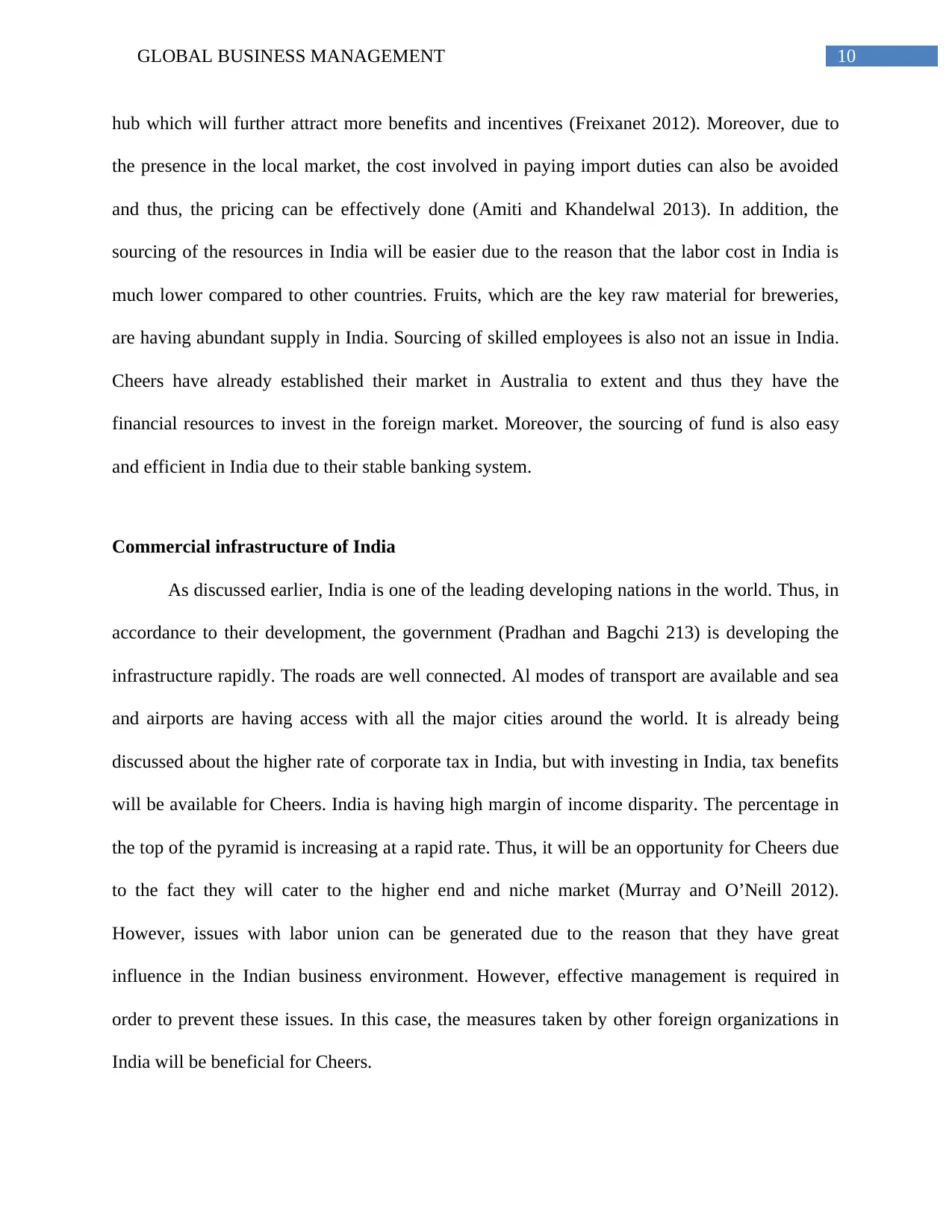
10GLOBAL BUSINESS MANAGEMENT
hub which will further attract more benefits and incentives (Freixanet 2012). Moreover, due to
the presence in the local market, the cost involved in paying import duties can also be avoided
and thus, the pricing can be effectively done (Amiti and Khandelwal 2013). In addition, the
sourcing of the resources in India will be easier due to the reason that the labor cost in India is
much lower compared to other countries. Fruits, which are the key raw material for breweries,
are having abundant supply in India. Sourcing of skilled employees is also not an issue in India.
Cheers have already established their market in Australia to extent and thus they have the
financial resources to invest in the foreign market. Moreover, the sourcing of fund is also easy
and efficient in India due to their stable banking system.
Commercial infrastructure of India
As discussed earlier, India is one of the leading developing nations in the world. Thus, in
accordance to their development, the government (Pradhan and Bagchi 213) is developing the
infrastructure rapidly. The roads are well connected. Al modes of transport are available and sea
and airports are having access with all the major cities around the world. It is already being
discussed about the higher rate of corporate tax in India, but with investing in India, tax benefits
will be available for Cheers. India is having high margin of income disparity. The percentage in
the top of the pyramid is increasing at a rapid rate. Thus, it will be an opportunity for Cheers due
to the fact they will cater to the higher end and niche market (Murray and O’Neill 2012).
However, issues with labor union can be generated due to the reason that they have great
influence in the Indian business environment. However, effective management is required in
order to prevent these issues. In this case, the measures taken by other foreign organizations in
India will be beneficial for Cheers.
hub which will further attract more benefits and incentives (Freixanet 2012). Moreover, due to
the presence in the local market, the cost involved in paying import duties can also be avoided
and thus, the pricing can be effectively done (Amiti and Khandelwal 2013). In addition, the
sourcing of the resources in India will be easier due to the reason that the labor cost in India is
much lower compared to other countries. Fruits, which are the key raw material for breweries,
are having abundant supply in India. Sourcing of skilled employees is also not an issue in India.
Cheers have already established their market in Australia to extent and thus they have the
financial resources to invest in the foreign market. Moreover, the sourcing of fund is also easy
and efficient in India due to their stable banking system.
Commercial infrastructure of India
As discussed earlier, India is one of the leading developing nations in the world. Thus, in
accordance to their development, the government (Pradhan and Bagchi 213) is developing the
infrastructure rapidly. The roads are well connected. Al modes of transport are available and sea
and airports are having access with all the major cities around the world. It is already being
discussed about the higher rate of corporate tax in India, but with investing in India, tax benefits
will be available for Cheers. India is having high margin of income disparity. The percentage in
the top of the pyramid is increasing at a rapid rate. Thus, it will be an opportunity for Cheers due
to the fact they will cater to the higher end and niche market (Murray and O’Neill 2012).
However, issues with labor union can be generated due to the reason that they have great
influence in the Indian business environment. However, effective management is required in
order to prevent these issues. In this case, the measures taken by other foreign organizations in
India will be beneficial for Cheers.
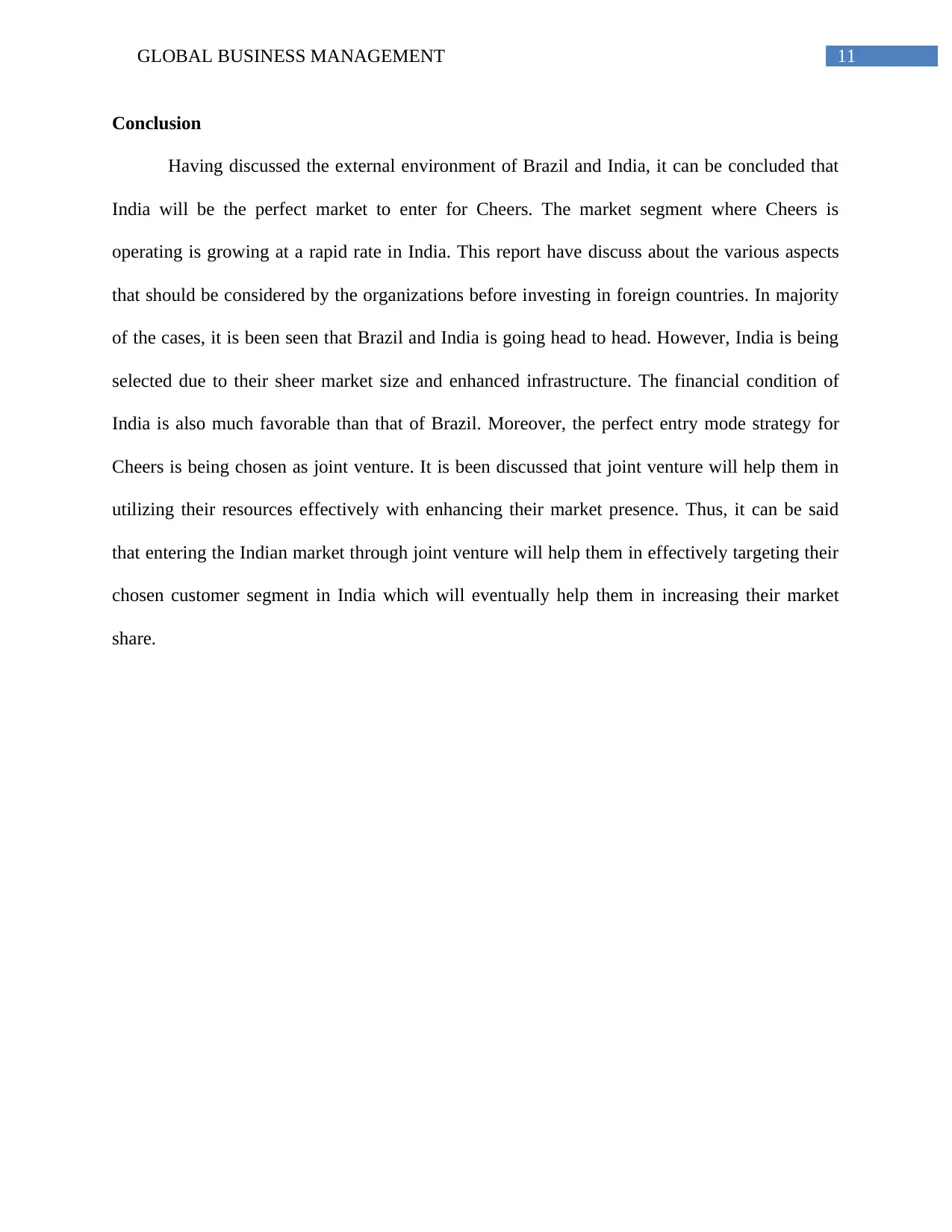
11GLOBAL BUSINESS MANAGEMENT
Conclusion
Having discussed the external environment of Brazil and India, it can be concluded that
India will be the perfect market to enter for Cheers. The market segment where Cheers is
operating is growing at a rapid rate in India. This report have discuss about the various aspects
that should be considered by the organizations before investing in foreign countries. In majority
of the cases, it is been seen that Brazil and India is going head to head. However, India is being
selected due to their sheer market size and enhanced infrastructure. The financial condition of
India is also much favorable than that of Brazil. Moreover, the perfect entry mode strategy for
Cheers is being chosen as joint venture. It is been discussed that joint venture will help them in
utilizing their resources effectively with enhancing their market presence. Thus, it can be said
that entering the Indian market through joint venture will help them in effectively targeting their
chosen customer segment in India which will eventually help them in increasing their market
share.
Conclusion
Having discussed the external environment of Brazil and India, it can be concluded that
India will be the perfect market to enter for Cheers. The market segment where Cheers is
operating is growing at a rapid rate in India. This report have discuss about the various aspects
that should be considered by the organizations before investing in foreign countries. In majority
of the cases, it is been seen that Brazil and India is going head to head. However, India is being
selected due to their sheer market size and enhanced infrastructure. The financial condition of
India is also much favorable than that of Brazil. Moreover, the perfect entry mode strategy for
Cheers is being chosen as joint venture. It is been discussed that joint venture will help them in
utilizing their resources effectively with enhancing their market presence. Thus, it can be said
that entering the Indian market through joint venture will help them in effectively targeting their
chosen customer segment in India which will eventually help them in increasing their market
share.
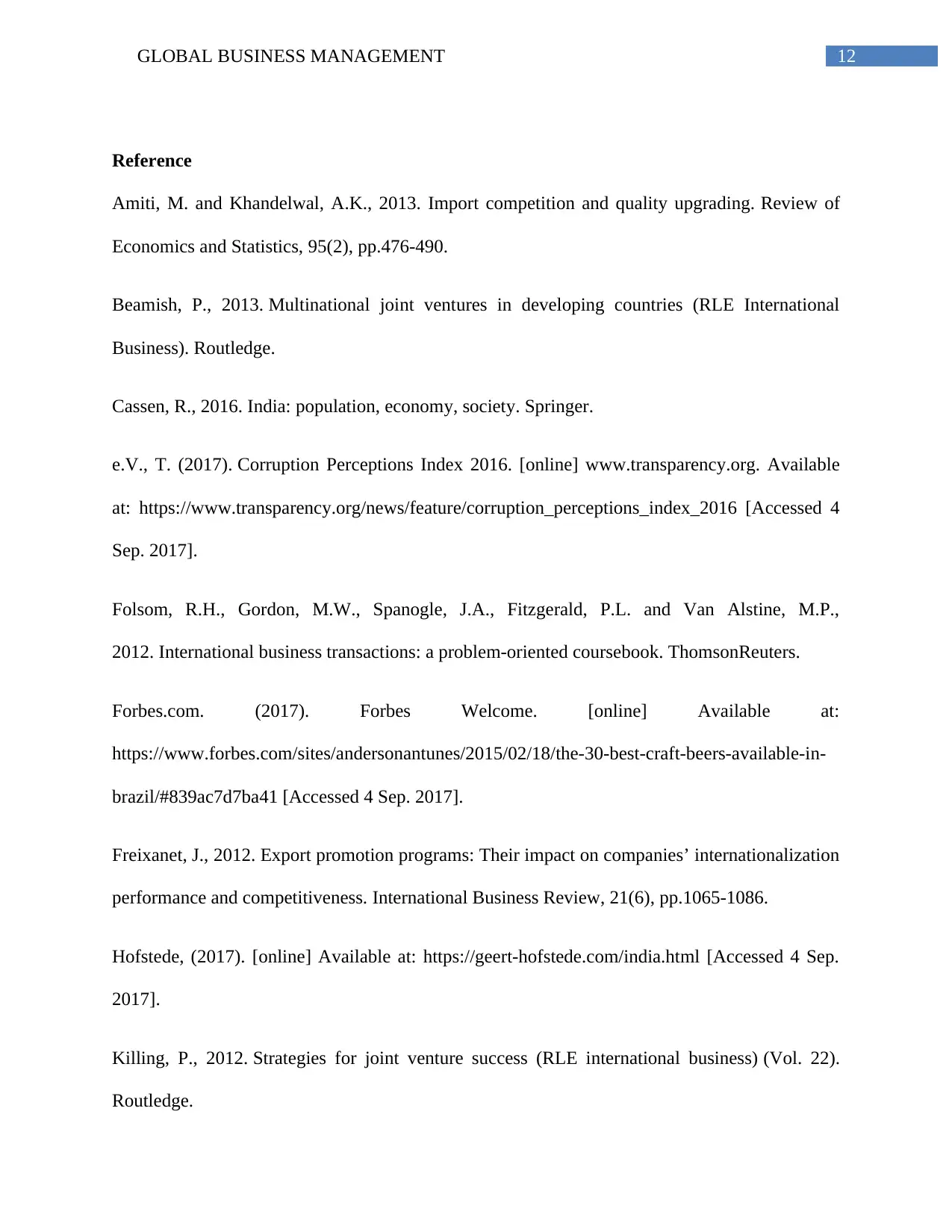
12GLOBAL BUSINESS MANAGEMENT
Reference
Amiti, M. and Khandelwal, A.K., 2013. Import competition and quality upgrading. Review of
Economics and Statistics, 95(2), pp.476-490.
Beamish, P., 2013. Multinational joint ventures in developing countries (RLE International
Business). Routledge.
Cassen, R., 2016. India: population, economy, society. Springer.
e.V., T. (2017). Corruption Perceptions Index 2016. [online] www.transparency.org. Available
at: https://www.transparency.org/news/feature/corruption_perceptions_index_2016 [Accessed 4
Sep. 2017].
Folsom, R.H., Gordon, M.W., Spanogle, J.A., Fitzgerald, P.L. and Van Alstine, M.P.,
2012. International business transactions: a problem-oriented coursebook. ThomsonReuters.
Forbes.com. (2017). Forbes Welcome. [online] Available at:
https://www.forbes.com/sites/andersonantunes/2015/02/18/the-30-best-craft-beers-available-in-
brazil/#839ac7d7ba41 [Accessed 4 Sep. 2017].
Freixanet, J., 2012. Export promotion programs: Their impact on companies’ internationalization
performance and competitiveness. International Business Review, 21(6), pp.1065-1086.
Hofstede, (2017). [online] Available at: https://geert-hofstede.com/india.html [Accessed 4 Sep.
2017].
Killing, P., 2012. Strategies for joint venture success (RLE international business) (Vol. 22).
Routledge.
Reference
Amiti, M. and Khandelwal, A.K., 2013. Import competition and quality upgrading. Review of
Economics and Statistics, 95(2), pp.476-490.
Beamish, P., 2013. Multinational joint ventures in developing countries (RLE International
Business). Routledge.
Cassen, R., 2016. India: population, economy, society. Springer.
e.V., T. (2017). Corruption Perceptions Index 2016. [online] www.transparency.org. Available
at: https://www.transparency.org/news/feature/corruption_perceptions_index_2016 [Accessed 4
Sep. 2017].
Folsom, R.H., Gordon, M.W., Spanogle, J.A., Fitzgerald, P.L. and Van Alstine, M.P.,
2012. International business transactions: a problem-oriented coursebook. ThomsonReuters.
Forbes.com. (2017). Forbes Welcome. [online] Available at:
https://www.forbes.com/sites/andersonantunes/2015/02/18/the-30-best-craft-beers-available-in-
brazil/#839ac7d7ba41 [Accessed 4 Sep. 2017].
Freixanet, J., 2012. Export promotion programs: Their impact on companies’ internationalization
performance and competitiveness. International Business Review, 21(6), pp.1065-1086.
Hofstede, (2017). [online] Available at: https://geert-hofstede.com/india.html [Accessed 4 Sep.
2017].
Killing, P., 2012. Strategies for joint venture success (RLE international business) (Vol. 22).
Routledge.
Paraphrase This Document
Need a fresh take? Get an instant paraphrase of this document with our AI Paraphraser
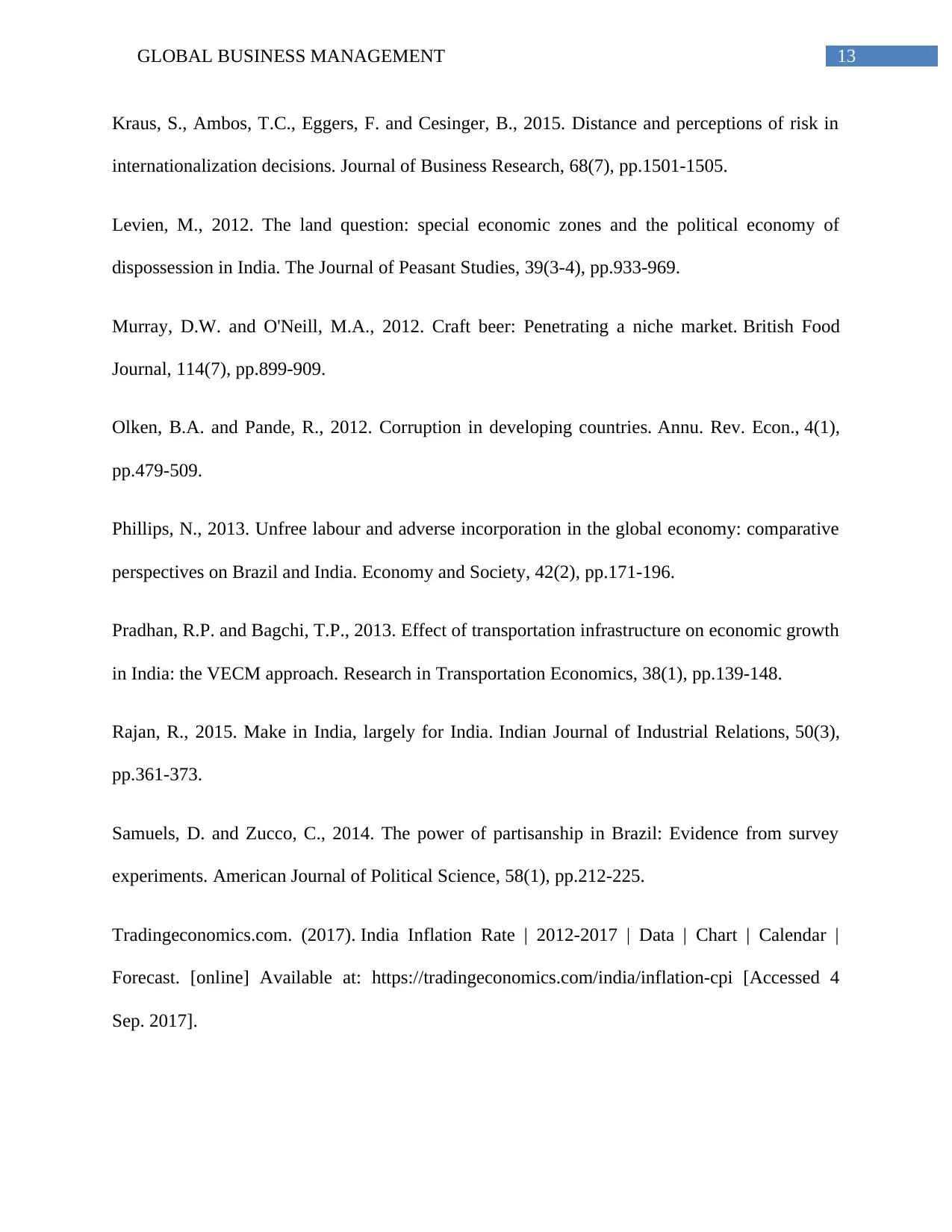
13GLOBAL BUSINESS MANAGEMENT
Kraus, S., Ambos, T.C., Eggers, F. and Cesinger, B., 2015. Distance and perceptions of risk in
internationalization decisions. Journal of Business Research, 68(7), pp.1501-1505.
Levien, M., 2012. The land question: special economic zones and the political economy of
dispossession in India. The Journal of Peasant Studies, 39(3-4), pp.933-969.
Murray, D.W. and O'Neill, M.A., 2012. Craft beer: Penetrating a niche market. British Food
Journal, 114(7), pp.899-909.
Olken, B.A. and Pande, R., 2012. Corruption in developing countries. Annu. Rev. Econ., 4(1),
pp.479-509.
Phillips, N., 2013. Unfree labour and adverse incorporation in the global economy: comparative
perspectives on Brazil and India. Economy and Society, 42(2), pp.171-196.
Pradhan, R.P. and Bagchi, T.P., 2013. Effect of transportation infrastructure on economic growth
in India: the VECM approach. Research in Transportation Economics, 38(1), pp.139-148.
Rajan, R., 2015. Make in India, largely for India. Indian Journal of Industrial Relations, 50(3),
pp.361-373.
Samuels, D. and Zucco, C., 2014. The power of partisanship in Brazil: Evidence from survey
experiments. American Journal of Political Science, 58(1), pp.212-225.
Tradingeconomics.com. (2017). India Inflation Rate | 2012-2017 | Data | Chart | Calendar |
Forecast. [online] Available at: https://tradingeconomics.com/india/inflation-cpi [Accessed 4
Sep. 2017].
Kraus, S., Ambos, T.C., Eggers, F. and Cesinger, B., 2015. Distance and perceptions of risk in
internationalization decisions. Journal of Business Research, 68(7), pp.1501-1505.
Levien, M., 2012. The land question: special economic zones and the political economy of
dispossession in India. The Journal of Peasant Studies, 39(3-4), pp.933-969.
Murray, D.W. and O'Neill, M.A., 2012. Craft beer: Penetrating a niche market. British Food
Journal, 114(7), pp.899-909.
Olken, B.A. and Pande, R., 2012. Corruption in developing countries. Annu. Rev. Econ., 4(1),
pp.479-509.
Phillips, N., 2013. Unfree labour and adverse incorporation in the global economy: comparative
perspectives on Brazil and India. Economy and Society, 42(2), pp.171-196.
Pradhan, R.P. and Bagchi, T.P., 2013. Effect of transportation infrastructure on economic growth
in India: the VECM approach. Research in Transportation Economics, 38(1), pp.139-148.
Rajan, R., 2015. Make in India, largely for India. Indian Journal of Industrial Relations, 50(3),
pp.361-373.
Samuels, D. and Zucco, C., 2014. The power of partisanship in Brazil: Evidence from survey
experiments. American Journal of Political Science, 58(1), pp.212-225.
Tradingeconomics.com. (2017). India Inflation Rate | 2012-2017 | Data | Chart | Calendar |
Forecast. [online] Available at: https://tradingeconomics.com/india/inflation-cpi [Accessed 4
Sep. 2017].
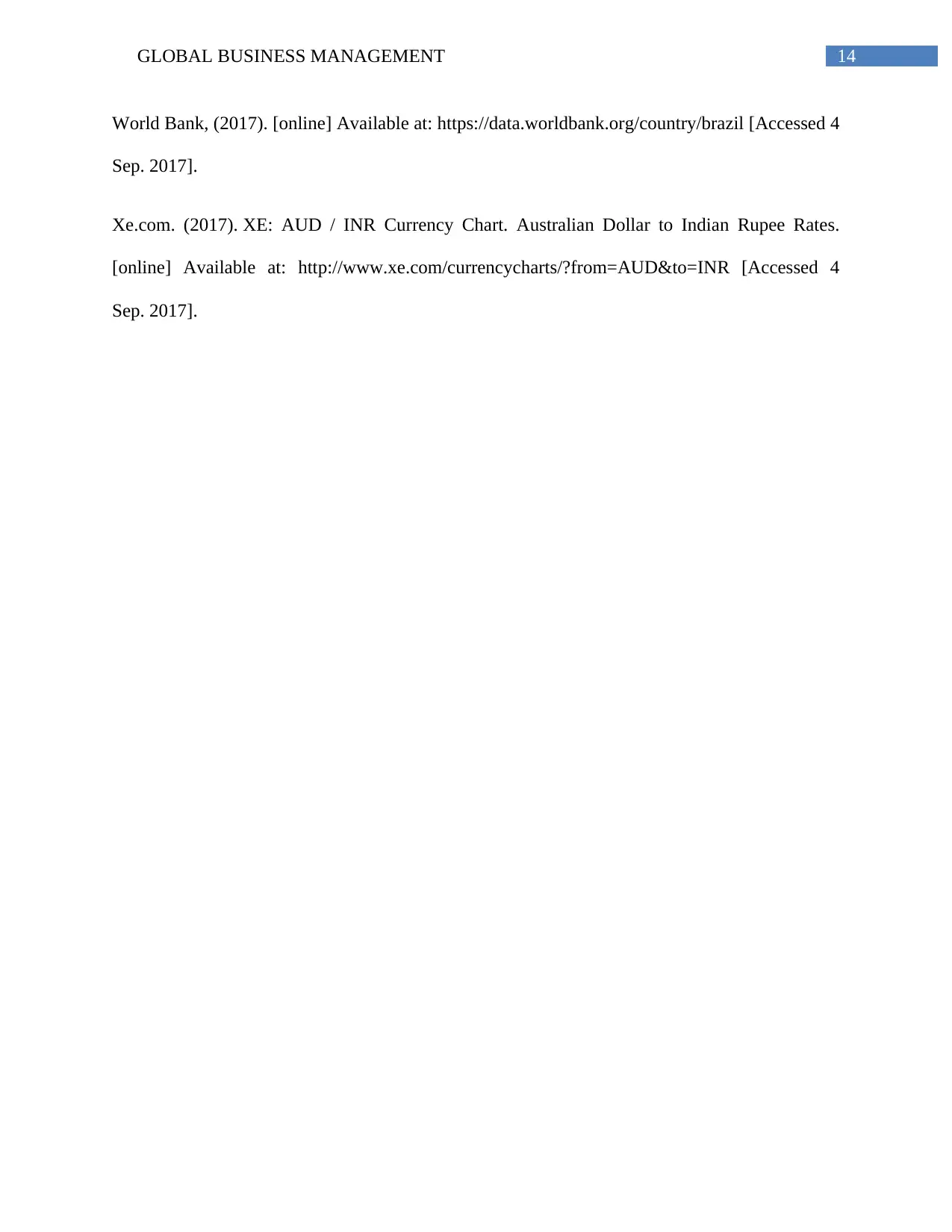
14GLOBAL BUSINESS MANAGEMENT
World Bank, (2017). [online] Available at: https://data.worldbank.org/country/brazil [Accessed 4
Sep. 2017].
Xe.com. (2017). XE: AUD / INR Currency Chart. Australian Dollar to Indian Rupee Rates.
[online] Available at: http://www.xe.com/currencycharts/?from=AUD&to=INR [Accessed 4
Sep. 2017].
World Bank, (2017). [online] Available at: https://data.worldbank.org/country/brazil [Accessed 4
Sep. 2017].
Xe.com. (2017). XE: AUD / INR Currency Chart. Australian Dollar to Indian Rupee Rates.
[online] Available at: http://www.xe.com/currencycharts/?from=AUD&to=INR [Accessed 4
Sep. 2017].
1 out of 15
Related Documents
Your All-in-One AI-Powered Toolkit for Academic Success.
+13062052269
info@desklib.com
Available 24*7 on WhatsApp / Email
![[object Object]](/_next/static/media/star-bottom.7253800d.svg)
Unlock your academic potential
© 2024 | Zucol Services PVT LTD | All rights reserved.





